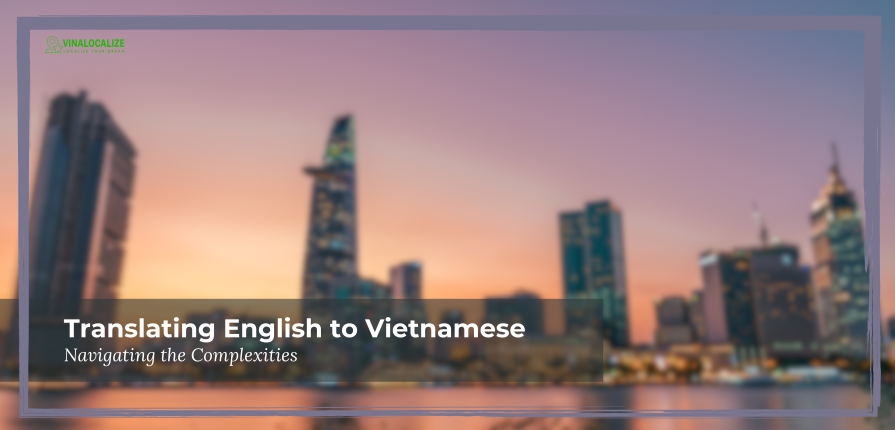In the global landscape, the importance of accurate translations cannot be overstated. Among the various linguistic challenges, translating English to Vietnamese presents a set of unique hurdles.
Let’s delve into these intricacies and explore effective strategies for achieving seamless translations.
Things to keep in mind when translating English to Vietnamese
Understanding Pronoun Complexity
Translating English pronouns into Vietnamese demands finesse, primarily due to intricate social nuances deeply embedded in the Vietnamese language. Navigating relationships, age disparities, and formality levels requires not only linguistic proficiency but also a profound understanding of the cultural context. This complexity adds layers to the translation process, where choices made in pronoun selection can significantly impact the overall meaning and reception of the content.
Tackling Loanwords and Foreign Influences
One notable challenge arises when English loanwords find their way into Vietnamese. Translators must tread carefully, balancing the preservation of the original meaning with the adaptation of pronunciation to fit the nuances of the Vietnamese language. This task involves a meticulous process to ensure that loanwords seamlessly integrate into the translated text, maintaining clarity and avoiding any unintended distortions.
Confronting the Challenge of Tones
English, as a language, lacks tonal distinctions, a stark contrast to the tonal intricacies present in the Vietnamese language. Misinterpreting or neglecting tones can lead to significant misunderstandings. Translators must navigate these tonal challenges with precision, ensuring that the intended meaning is accurately conveyed in the translated text. This involves not only recognizing tone markers but also understanding their impact on the overall message.

Cultural References and Context
The richness of Vietnamese culture is reflected in its language. It has a plethora of cultural references that may lack direct equivalents in English. Therefore, translators must skillfully find substitutes that convey the intended meaning without compromising the essence of the original content. This delicate dance between linguistic accuracy and cultural resonance is crucial to delivering effective translations that resonate with Vietnamese audiences.
Adapting to Vietnamese Formality Levels
Vietnamese employs distinct pronouns and verb forms to indicate formality levels, a feature absent in English. Translators must accurately convey these nuances in English, preserving the level of politeness inherent in the source text. The challenge lies not only in linguistic precision but also in capturing the subtle social dynamics embedded in Vietnamese formality levels.
Abbreviations and Acronyms Dilemma
Translating English abbreviations and acronyms into Vietnamese poses a distinct challenge. The meaning of these abbreviations may not be immediately apparent in Vietnamese, necessitating a meticulous approach to ensure clarity in the translated content. This involves not only providing accurate translations but also considering the potential cultural connotations associated with specific abbreviations.
Cultural Sensitivity in Marketing
Adapting marketing content from English to Vietnamese requires linguistic prowess and a deep understanding of cultural sensitivities. Certain marketing messages and cultural references that may be effective in English-speaking markets may not resonate similarly across languages and cultures. Translators must navigate these cultural nuances to ensure that marketing content maintains its impact and relevance in the Vietnamese context.
Handling English Colloquialisms
English colloquial expressions may lack direct counterparts in Vietnamese, posing a unique challenge for translators. Navigating this challenge involves not only understanding the cultural connotations behind these colloquialisms but also finding Vietnamese equivalents that capture the intended meaning. This requires a nuanced approach to ensure that the translated content remains both linguistically accurate and culturally resonant.
Maintaining Syntactic Harmony
Vietnamese often employs different syntactic patterns than English, requiring translators to adjust sentence structures for coherence and clarity. Understanding and adapting to these syntactic differences are crucial for successful translations, ensuring that the flow and meaning of the original text are preserved in the translated version.
Transition Words for Coherence
Integrating transition words enhances the flow of translated content, providing a seamless reading experience for the audience. Words like “however,” “moreover,” and “consequently” guide the reader through the text, ensuring that the translation maintains coherence and readability. These transition words serve as the glue that holds the translated content together, contributing to a more natural and impactful reading experience.
Seeking Feedback for Refinement
Translation is inherently a collaborative process. Seeking feedback from native Vietnamese speakers and proficient English speakers is essential for refining translations. Their insights offer valuable perspectives on linguistic nuances and cultural appropriateness, contributing to the overall accuracy and effectiveness of the translated content.
Staying Updated on Language Evolution
Languages, including Vietnamese, undergo continuous evolution. Staying attuned to linguistic shifts, emerging expressions, and changes in usage is crucial for translators. This ongoing awareness ensures that translations remain relevant and aligned with contemporary language usage, thus contributing to communication effectiveness in dynamic linguistic landscapes.
Embracing Continuous Learning
Translation is a dynamic skill that thrives on continuous learning. Engaging with Vietnamese literature, attending language courses, and immersing oneself in Vietnamese culture are integral components of this learning process. This commitment to continuous learning enhances translation abilities and keeps skills sharp, hence ensuring that translators remain adept at navigating the evolving landscape of the English-to-Vietnamese translation domain.
In conclusion
Translating from English to Vietnamese is a nuanced and multifaceted process that goes beyond mere linguistic proficiency. It requires a deep understanding of cultural nuances, and context-specific considerations, as well as the ability to adapt to the unique linguistic features of Vietnamese.
By navigating these challenges with finesse and embracing continuous learning, translators can bridge the gap between English and Vietnamese, thus facilitating effective communication in our interconnected world.



